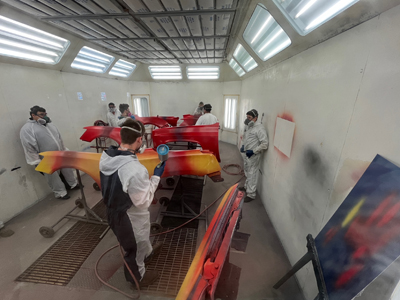The color of a vehicle can make a statement, but getting the perfect shade can be a challenge.
Texas State Technical College’s auto collision and management technology program offers a refinishing component for students who have an interest in auto body work and painting. The program is taught in a hybrid format, with students watching lectures online and doing hands-on labs on campus.
“Most students come in and never have held a paint gun or worked in a shop,” said William Graham, a program instructor.
The Program
All students wear personal protective equipment when working with paints, whether mixing or in paint booths. This involves a suit, respirator, gloves and glasses or goggles.
Graham said students start the first semester learning how to use and clean a paint gun. He said students learn to read technical data sheets for spraying products and how to color, sand and buff.
Graham said second-semester students purchase their own paint guns and mix their own paint, along with doing scratch repairs. They also do block sanding.
Philip McKee, lead instructor in the program, said some students are surprised at the mathematics and science involved in creating colors and painting.
Refinishing students in the third semester learn about application techniques for water-based paints and are introduced to blending methods. Students also learn how to paint on aluminum, fiberglass and plastic.
Graham said each vehicle has its own manufacturer's paint code, which means that students have to be careful in matching paint colors for refinishing work.
Refinishing students in the fourth semester learn about color theory and how people perceive colors, how colors work, and how to tint colors to do blending matches.
The Painting
The program uses Sherwin-Williams paints. Students in the first and second semesters use solvent-based paint, while students in the third and fourth semesters use water-based paint.
“They (the students) are getting introduced to both,” McKee said. “It is not a culture shock when they go out into industry.”
Both kinds of paints have their differences.
McKee said solvent-based paint is quicker to use in painting. He said unlike solvent-based paint, students and those in industry cannot control the evaporation pace of water-based paint. Venturi dryers are used to dehydrate the paint so it does not have a wet look.
The program has used water-based paint since the early 2010s.
McKee said the water-based paint has a different smell and looks more like house paint when being mixed. The water-based paint has a longer evaporation process.
Sherwin-Williams conducts a class for students to get certified in its Ultra 9K Waterborne Refinish System.
Workers Needed
Automotive body and related repairers in Texas made a yearly median salary of more than $46,000 in 2021, according to the U.S. Department of Labor’s CareerOneStop website.
The Dallas-Fort Worth-Arlington and The Woodlands-Houston-Sugar Land metropolitan areas had the highest concentration of automotive body and related repairers in Texas as of May 2022, according to the U.S. Bureau of Labor Statistics.
Texas will need more than 13,000 automotive body and related repairers in 2030, according to the CareerOneStop website.
What to Study
TSTC offers associate's degrees in auto collision and management technology with refinishing and repair specializations at its Harlingen and Waco campuses. Certificate options and an occupational skills achievement award also are available.
Registration continues for the fall semester at TSTC. For more information, go to tstc.edu.
Source: TSTC













